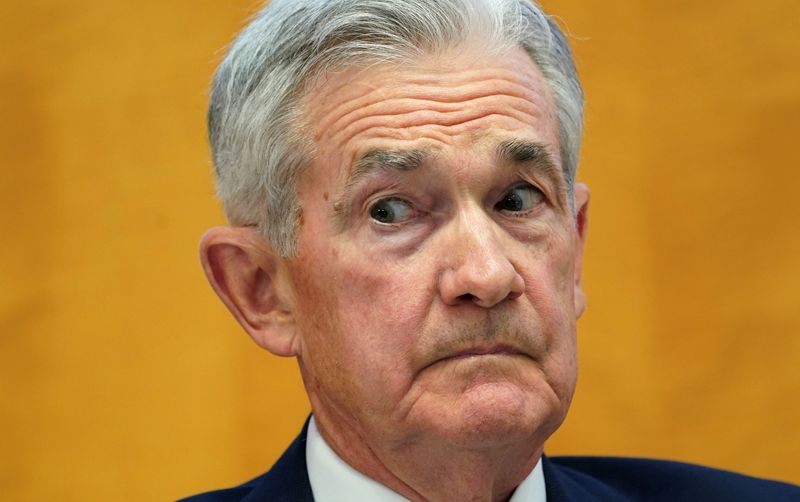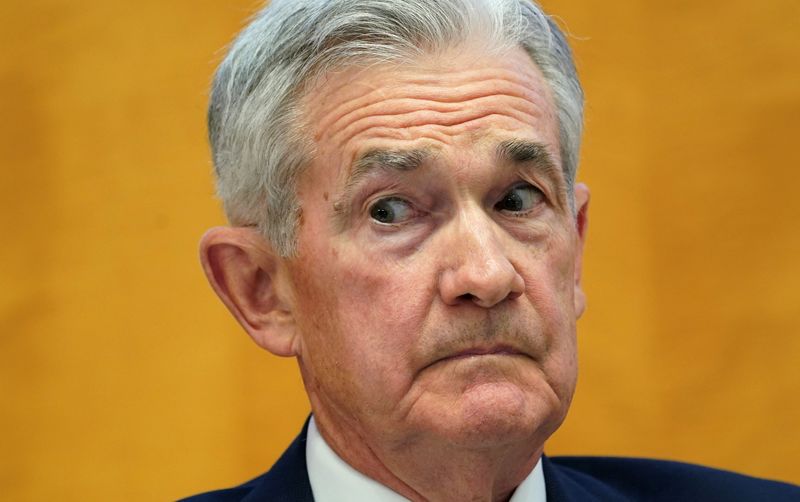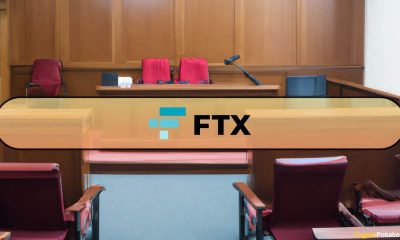Economy
Fed to move ‘carefully’ on interest rates as ‘soft landing’ takes shape, Powell says


© Reuters. FILE PHOTO: Federal Reserve Chair Jerome Powell reacts to introductory remarks before speaking on “Monetary Policy Challenges in a Global Economy” during the international Monetary Fund’s (IMF) annual research conference on “Global Interdependence” in Was
By Howard Schneider
ATLANTA (Reuters) -The risks of the Federal Reserve moving too far with interest rate hikes, and slowing the economy more than necessary, have become “more balanced” with those of not moving high enough to control inflation, Fed Chair Jerome Powell said on Friday in remarks reaffirming the U.S. central bank’s intent to be cautious in its upcoming monetary policy decisions.
Noting that a key measure of inflation averaged 2.5% over the six months ending in October, near the Fed’s 2% target, Powell said it was clear that U.S. monetary policy was slowing the economy as expected with a benchmark overnight interest rate “well into restrictive territory.”
“The full effects of our tightening have likely not yet been felt. The forcefulness of our response to inflation also helped maintain the Fed’s hard-won credibility, ensuring that the public’s expectations of future inflation remain well-anchored,” Powell said in remarks at Spelman College in Atlanta. “Having come so far so quickly, the (Federal Open Market Committee) is moving forward carefully, as the risks of under- and over-tightening are becoming more balanced.”
Powell reiterated, as his colleagues have in recent weeks, that it was still too early to declare the Fed’s inflation fight finished, with prices rising 3.0% annually by the measure the central bank uses to set its target. Prices as of October were up 3.5% when stripped of food and energy costs, a measure the Fed sees as a better guide of inflation’s trend.
“We are prepared to tighten policy further if it becomes appropriate to do so,” he said.
But his remarks also reflected increased confidence that the current 5.25%-5.50% policy rate may well be adequate to complete the job. The Fed meets on Dec. 12-13 and is expected to leave its benchmark rate unchanged for the third meeting in a row.
“(Powell) used the word ‘balanced,’ and the message he’s sending is the Fed is not going to change its rhetoric, but things are going the way they want them to go and they’re not going to raise rates again,” said Peter Cardillo, chief market economist at Spartan Capital Securities. “They’re done, they’re finished, and that’s what the market thinks.”
U.S. stocks reversed earlier losses and were trading marginally higher after Powell’s remarks, and traders of interest rate futures added to bets the Fed would leave rates steady at its December and January policy meetings, and then start cutting rates at its March meeting.
Powell fielded questions after his speech in a conversation with Spelman College President Helene Gayle. He was scheduled to be joined by Fed Governor Lisa Cook, who earned her bachelor’s degree at the historically black institution, in an afternoon roundtable discussion with local entrepreneurs.
‘SOFT LANDING’
The Fed chief said policymakers still regard the uncertainty in the economic outlook to be “unusually elevated,” one factor in their insistence that rates may still need to rise.
But he also said that the broad outlines of the hoped-for “soft landing” seemed to be falling into place, with the job market still strong even as growth in spending and output slows and price pressures abate.
“My colleagues and I anticipate that growth in spending and output will slow over the next year, as the effects of the pandemic and the reopening fade and as restrictive monetary policy weighs on aggregate demand,” Powell said.
“The pace at which the economy is creating new jobs remains strong, and has been slowing toward a more sustainable level … Wage growth remains high, but has been gradually moving toward levels that would be more consistent with 2% price inflation over time, and real wages are growing again as inflation declines,” he said.
Shortly before Powell delivered his remarks, a key reading on the health of the U.S. manufacturing sector showed activity there remained subdued and factory employment declined. The Institute for Supply Management’s Purchasing Managers Index has now indicated the sector has been in contraction for 13 straight months, the longest such run in more than two decades, as demand for goods continues to soften.
Economy
Russian central bank says it needs months to make sure CPI falling before rate cuts -RBC


© Reuters. Russian Central Bank Governor Elvira Nabiullina attends a news conference in Moscow, Russia June 14, 2019. REUTERS/Shamil Zhumatov/File Photo
MOSCOW (Reuters) – Russia’s central bank will need two to three months to make sure that inflation is steadily declining before taking any decision on interest rate cuts, the bank’s governor Elvira Nabiullina told RBC media on Sunday.
The central bank raised its key interest rate by 100 basis points to 16% earlier in December, hiking for the fifth consecutive meeting in response to stubborn inflation, and suggested that its tightening cycle was nearly over.
Nabiullina said it was not yet clear when exactly the regulator would start cutting rates, however.
“We really need to make sure that inflation is steadily decreasing, that these are not one-off factors that can affect the rate of price growth in a particular month,” she said.
Nabiullina said the bank was taking into account a wide range of indicators but primarily those that “characterize the stability of inflation”.
“This will take two or three months or more – it depends on how much the wide range of indicators that characterize sustainable inflation declines,” she said.
The bank will next convene to set its benchmark rate on Feb. 16.
The governor also said the bank should have started monetary policy tightening earlier than in July, when it embarked on the rate-hiking cycle.
Economy
China identifies second set of projects in $140 billion spending plan


© Reuters. FILE PHOTO: Workers walk past an under-construction area with completed office towers in the background, in Shenzhen’s Qianhai new district, Guangdong province, China August 25, 2023. REUTERS/David Kirton/File Photo
SHANGHAI (Reuters) – China’s top planning body said on Saturday it had identified a second batch of public investment projects, including flood control and disaster relief programmes, under a bond issuance and investment plan announced in October to boost the economy.
With the latest tranche, China has now earmarked more than 800 billion yuan of its 1 trillion yuan ($140 billion) in additional government bond issuance in the fourth quarter, as it focuses on fiscal steps to shore up the flagging economy.
The National Development and Reform Commission (NDRC) said in a statement on Saturday it had identified 9,600 projects with planned investment of more than 560 billion yuan.
China’s economy, the world’s second largest, is struggling to regain its footing post-COVID-19 as policymakers grapple with tepid consumer demand, weak exports, falling foreign investment and a deepening real estate crisis.
The 1 trillion yuan in additional bond issuance will widen China’s 2023 budget deficit ratio to around 3.8 percent from 3 percent, the state-run Xinhua news agency has said.
“Construction of the projects will improve China’s flood control system, emergency response mechanism and disaster relief capabilities, and better protect people’s lives and property, so it is very significant,” the NDRC said.
The agency said it will coordinate with other government bodies to make sure that funds are allocated speedily for investment and that high standards of quality are maintained in project construction.
($1 = 7.1315 renminbi)
Economy
Russian central bank says it needs months to make sure CPI falling before rate cuts -RBC


© Reuters. Russian Central Bank Governor Elvira Nabiullina attends a news conference in Moscow, Russia June 14, 2019. REUTERS/Shamil Zhumatov/File Photo
MOSCOW (Reuters) – Russia’s central bank will need two to three months to make sure that inflation is steadily declining before taking any decision on interest rate cuts, the bank’s governor Elvira Nabiullina told RBC media on Sunday.
The central bank raised its key interest rate by 100 basis points to 16% earlier in December, hiking for the fifth consecutive meeting in response to stubborn inflation, and suggested that its tightening cycle was nearly over.
Nabiullina said it was not yet clear when exactly the regulator would start cutting rates, however.
“We really need to make sure that inflation is steadily decreasing, that these are not one-off factors that can affect the rate of price growth in a particular month,” she said.
Nabiullina said the bank was taking into account a wide range of indicators but primarily those that “characterize the stability of inflation”.
“This will take two or three months or more – it depends on how much the wide range of indicators that characterize sustainable inflation declines,” she said.
The bank will next convene to set its benchmark rate on Feb. 16.
The governor also said the bank should have started monetary policy tightening earlier than in July, when it embarked on the rate-hiking cycle.

 Forex3 years ago
Forex3 years agoForex Today: the dollar is gaining strength amid gloomy sentiment at the start of the Fed’s week

 Forex3 years ago
Forex3 years agoUnbiased review of Pocket Option broker

 Forex3 years ago
Forex3 years agoDollar to pound sterling exchange rate today: Pound plummeted to its lowest since 1985

 Forex3 years ago
Forex3 years agoHow is the Australian dollar doing today?

 Cryptocurrency3 years ago
Cryptocurrency3 years agoWhat happened in the crypto market – current events today

 World3 years ago
World3 years agoWhy are modern video games an art form?

 Commodities3 years ago
Commodities3 years agoCopper continues to fall in price on expectations of lower demand in China

 Economy3 years ago
Economy3 years agoCrude oil tankers double in price due to EU anti-Russian sanctions























